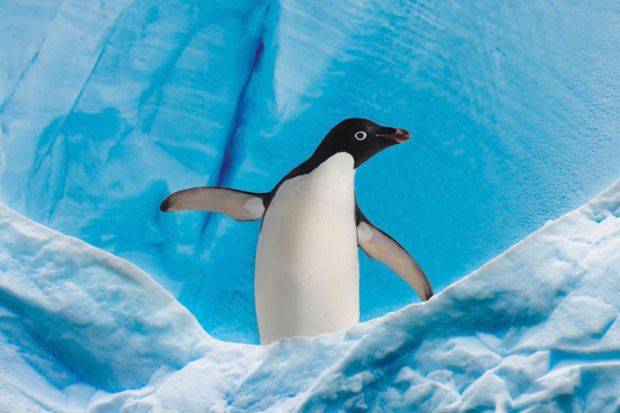A scientist has worked with game designers to help her get across a vital message about what is happening to the Antarctic.
Anne Le Brocq, senior lecturer in physical geography at the University of Exeter, has long been aware of “the difficulties of communicating the dynamism of the Antarctic Ice Sheet to non-specialists. Pictures and satellite images of Antarctica often portray a large white mass in a stationary snapshot, so it is hard to get across how dynamic and changing the ice sheet is over short and long timescales.”
Although “visual simulations help”, Dr Le Brocq saw much greater potential in “a computer game with multiple levels, [which] means the user is immersed in the environment for a period of time, and needs to understand the controls on the system in order to achieve their goal, which is completion of all the levels and earning new penguins.
“Game-based learning and science share the common goal of understanding the rules of a system to achieve an aim, so a game is the perfect tool to use to convey a complex system.”
To make this happen, Dr Le Brocq secured funding from the Natural Environment Research Council and joined forces with games developers Inhouse Visuals and Questionable Quality, the British Antarctic Survey and other scientists working in the area.
Their new Ice Flows game has just been launched at the SCAR (Scientific Committee for Antarctic Research) Open Science Conference in Kuala Lumpur and will be free to download from app stores.
So how does the game strike the right balance between entertaining and informing – and perhaps encouraging people to change their behaviour?
“First you need to entertain to draw in the player,” responds Dr Le Brocq, “then inform through the understanding that is gained by playing the game. If that understanding leads to a change in behaviour, then that would be great, but it must first begin with being informed.
“There is so much misrepresentation of changes in ice sheets and glaciers in the media that it is hard for people, for example, to know when an iceberg breaking off an ice sheet is a ‘bad’ thing and when it is part of the natural part of the life cycle of an ice sheet. Hopefully the game will enable people to move beyond the headlines and allow them to interpret the situation themselves, and to understand the implications of the story for their own lives.”
She said that working with game developers “meant that the balance between being scientifically accurate and fun to play was an iterative process”.
“I knew what the scientific message was and what was important to me to communicate, and they knew what made a fun and addictive game. Rather than set out to make an ‘educational game’ and try and make it fun, we set out to make a fun game with an underlying educational message.”
The development of the game forms part of a broader research project on the Filchner Ice Shelf system, which combines field measurement with numerical modelling of ice floes, ocean currents and the atmosphere.
Register to continue
Why register?
- Registration is free and only takes a moment
- Once registered, you can read 3 articles a month
- Sign up for our newsletter
Subscribe
Or subscribe for unlimited access to:
- Unlimited access to news, views, insights & reviews
- Digital editions
- Digital access to THE’s university and college rankings analysis
Already registered or a current subscriber? Login








